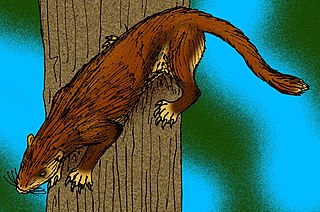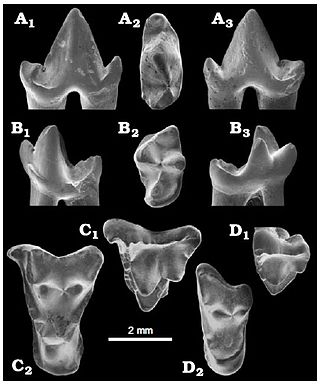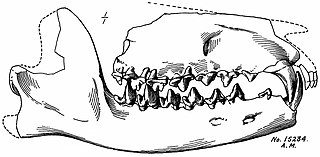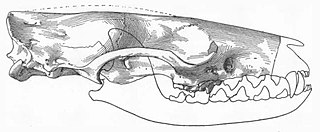
Bisonalveus is an extinct genus of shrew-like mammals that were presumably ground-dwelling and fed on plants and insects. Bisonalveus fossils have been discovered in the upper Great Plains region of North America, including sites in modern-day Wyoming, North Dakota, Montana, and Alberta. The fossils have been dated to 60 million years ago, during the Tiffanian North American Stage of the Palaeocene epoch. Bisonalveus is the last known genus of the Pentacodontinae sub-family to have arisen, replacing the genus Coriphagus in the early Tiffanian. Bisonalveus itself appears to have gone extinct by the middle Tiffanian.

Oxyaenidae is a family of extinct carnivorous placental mammals. Traditionally classified in order Creodonta, this group is now classified in its own order Oxyaenodonta within clade Pan-Carnivora in mirorder Ferae. The group contains four subfamilies comprising fourteen genera. Oxyaenids were the first to appear during the late Paleocene in North America, while smaller radiations of oxyaenids in Europe and Asia occurred during the Eocene.

Oxyaena is an extinct genus of placental mammals from extinct subfamily Oxyaeninae within extinct family Oxyaenidae, that lived in Europe, Asia and North America during the early Eocene.

Barylambda is an extinct genus of pantodont mammal from the middle to late Paleocene, well known from several finds in the Wasatchian DeBeque Formation of Colorado and the Clarkforkian Wasatch Formation to Tiffanian Fort Union Formation in Wyoming. Three species of Barylambda are currently recognized. The creature likely lived a life similar to that of a modern tapir, browsing on foliage and soft vegetation. Barylambda seems to have been quite successful for an early pantodont, though eventually it seems to have been replaced in its ecosystem by other pantodonts, such as Coryphodon.

Carnivoramorpha is a clade of placental mammals of clade Pan-Carnivora from mirorder Ferae, that includes the modern order Carnivora and its extinct stem-relatives.
Xinyuictis is an extinct genus of placental mammals from clade Carnivoraformes, that lived in Asia from the early to late Eocene.

Didymictis is an extinct genus of placental mammals from extinct subfamily Didymictinae within extinct family Viverravidae, that lived in North America and Europe from the late Paleocene to middle Eocene.
Intyrictis is an extinct genus of placental mammals from extinct subfamily Didymictinae within extinct family Viverravidae, that lived in North America during the early Paleocene.

Raphictis is an extinct genus of placental mammals from extinct subfamily Didymictinae within extinct family Viverravidae, that lived in North America during late Paleocene.

Tillodontia is an extinct suborder of eutherian mammals known from the Early Paleocene to Late Eocene of China, the Late Paleocene to Middle Eocene of North America where they display their maximum species diversity, the Middle Eocene of Pakistan, and the Early Eocene of Europe. Leaving no descendants, they are most closely related to the pantodonts, another extinct group. The tillodonts were medium- to large-sized animals that probably fed on roots and tubers in temperate to subtropical habitats.

Ectocion is an extinct genus of placental mammals of the family Phenacodontidae. The genus was earlier classified as Gidleyina and Prosthecion It reached 6 to 12 kg and was similar in size and morphology to Copecion. Both these herbivorous ungulates likely occupied similar ecological niches.

Hyopsodontidae is an extinct family of primitive mammals, initially assigned to the order Condylarthra, living from the Paleocene to the Eocene in North America and Eurasia. Condylarthra is now thought to be a wastebasket taxon; hyopsodontids have occasionally been speculated to be related to Afrotheria, but the most recent consensus is that they are related to Perissodactyla. Analysis of the inner ear shows shared characteristics with the Equoidea ; they may be a basal ungulate group near to perissodactyls.

Gracilocyon is an extinct paraphyletic genus of placental mammals from clade Carnivoraformes, that lived in North America and Europe from the late Paleocene to the early Eocene.
The Willwood Formation is a sedimentary sequence deposited during the late Paleocene to early Eocene, or Clarkforkian, Wasatchian and Bridgerian in the NALMA classification.

The Wasatch Formation (Tw) is an extensive highly fossiliferous geologic formation stretching across several basins in Idaho, Montana, Wyoming, Utah and western Colorado. It preserves fossils dating back to the Early Eocene period. The formation defines the Wasatchian or Lostcabinian, a period of time used within the NALMA classification, but the formation ranges in age from the Clarkforkian to Bridgerian.

Pyrocyon is an extinct genus of small carnivorous placental mammals from extinct order Hyaenodonta, that lived in North America during the early Eocene. Fossils of Pyrocyon have been found in Wyoming and Colorado. Weight of Pyrocyon dioctetus has been estimated at around 2.6 kilograms.

Viverravus is an extinct genus of placental mammals from extinct subfamily Viverravinae within extinct family Viverravidae, that lived in North America, Europe and Asia from the middle Paleocene to middle Eocene.
Wyonycteris is a genus of small mammals that existed in the late Paleocene and early Eocene epochs. The type species is Wyonycteris chalix, which lived in Wyoming during the Clarkforkian North American Land Mammal Age of the Paleocene and was originally proposed to be an early form of insectivorous bat. Later re-examination of the material has put this alliance in doubt, and the genus has instead been proposed as belonging to the subfamily Placentidentinae, within the family Nyctitheriidae. Similar fossil material of the same time period found in Europe was later discovered and described as new species, Wyonycteris richardi.
Chiromyoides is a small plesiadapid primatomorph that is known for its unusually robust upper and lower incisors, deep dentary, and comparatively small cheek teeth. Species of Chiromyoides are known from the middle Tiffanian through late Clarkforkian North American Land Mammal Ages (NALMA) of western North America, and from late Paleocene deposits in the Paris Basin, France.
Azygonyx was a small tillodont mammal, likely the size of a cat to raccoon, that lived in North America during the Paleocene and Eocene in the early part of the Cenozoic Era. The only fossils that have been recovered are from the Willwood and Fort Union Formations in the Bighorn Basin of Wyoming, United States, and date to the Clarkforkian to Wasatchian, about 56 to 50 million years ago. Fifty-six collections that have been recovered thus far include the remains of Azygonyx. Azygonyx survived the Paleocene Eocene Thermal Maximum along with other mammals like Phenacodus and Ectocion, both of which were ground-dwelling mammals. Azygonyx probably was a generalist terrestrial mammal that may have roamed around the ground, but was also capable of climbing trees.













